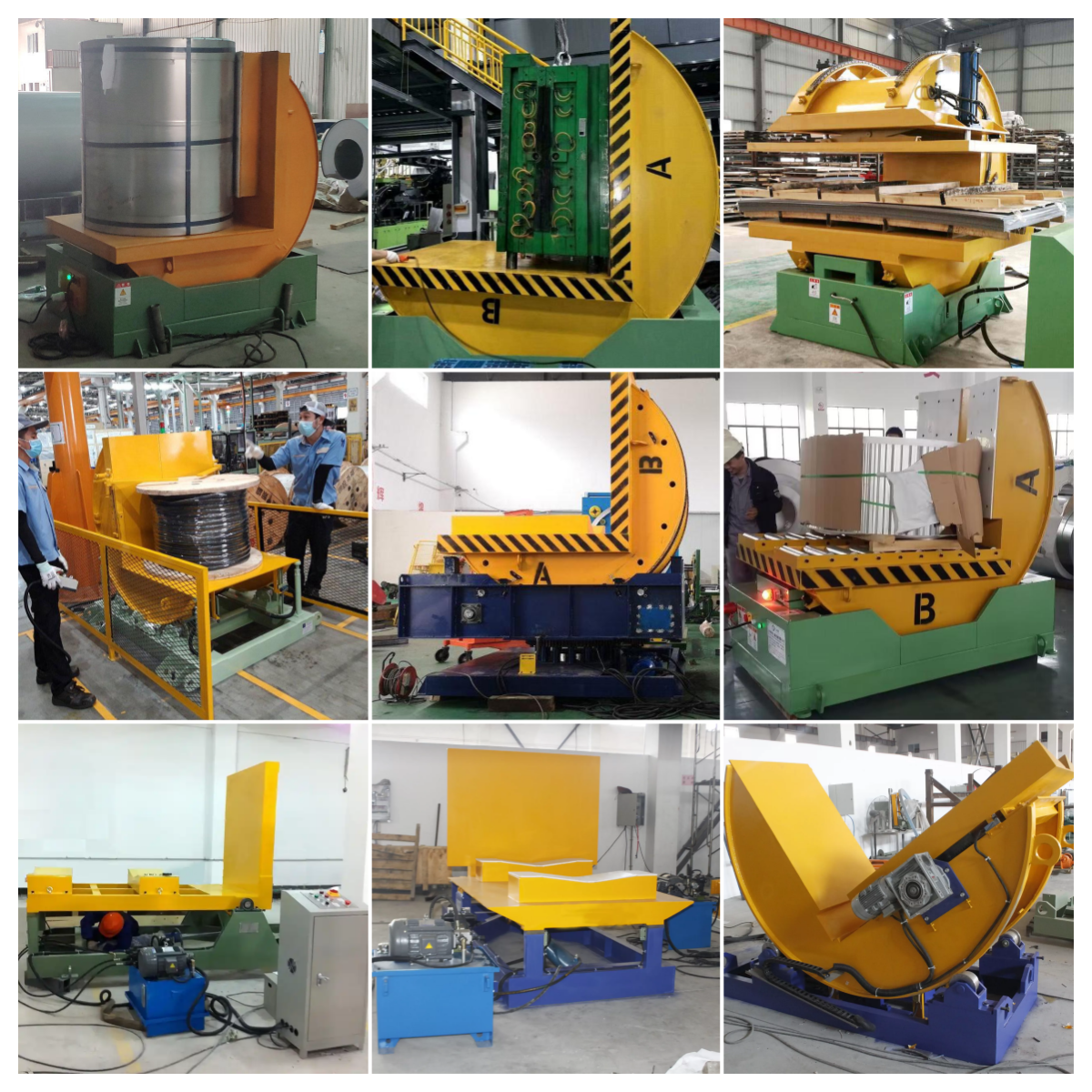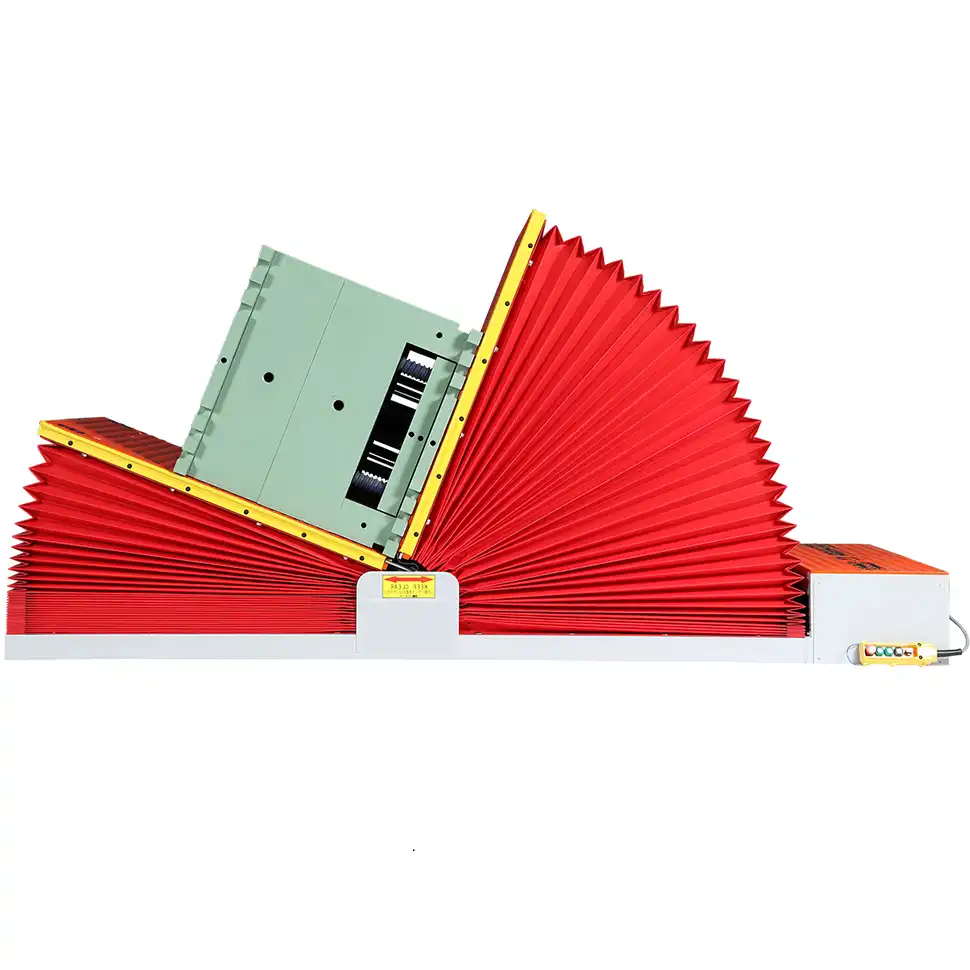Hydraulic Upender on floor base
Description:
Hydraulic upender/Tilter is mainly applied to turn heavy objects in operation. The device includes heavy duty structure and hydraulic station.
Characteristics of hydraulic turnover machine:
1. Heavy structure hydraulic turnover machine.
2. Reliable hydraulic station.
3. Fast, safe and stable.
4. There are two devices to ensure safe operation.
5. Safe operation of two kinds of hydraulic modes
6. Emergency stop and lock-in function to avoid rotation.
Control:
1. Manual control box or remote control.
2. Speed adjustable
Parameters:
|
|
FPCT-03
|
FPCT-10
|
FPCT-20
|
FPCT-40
|
|
Power Supply (V/Hz)
|
AC 380/50( or your requirement)
|
|
Power consumption (KW)
|
0.45
|
0.45
|
0.75
|
0.75
|
|
Max. Loading
|
3T
|
10T
|
30T
|
40T
|
|
Speed (sec/set)
|
20-40
|
20-40
|
20-40
|
20-50
|
The handling equipment hydraulic turnover machine, the design and manufacture of flip is carried out at our headquarters in Shanghai, China. Our engineers deal with sales, service and global customer support through our office.
This machine can be customized according to customer's requirements.
1. The transmission system is a hydraulic system
2. Two working tables: Flat table+ V side table.
3. Package Loading and uploading way by forklifter
The hydralic upender and tilter is very common all over the world in the load handling. In order to meet the modern demanding industries and provide higher productivity, great attention has been paid to the safety of large and very heavy materials when they are tilted at 90, 180 and 360. Nowadays, for companies that need a high level of safety and productivity, overhead cranes or forklifts are widely used to turn over heavy objects. So FHOPE providing the customized solution vary from the handling way and requirement.
Customization Options in Hydraulic Upender: How to Loading and Unloading Floor Level?
Hydraulic upenders have become an indispensable part of industrial operations. For manufacturers dealing with heavy and complex loads, these machines provide a seamless way to handle material rotations safely and efficiently. While their core functionality is impressive, their real value often lies in the ability to customize them to specific operational needs. But when it comes to loading and unloading at floor level, what are the options available? Let’s explore.
Industrial demands are anything but static. Businesses in sectors like steel manufacturing, automotive, and logistics need solutions tailored to their workflows. A hydraulic upender designed for easy loading and unloading at floor level can drastically improve efficiency, reduce manual labor, and enhance workplace safety. Understanding how these machines can be customized is the key to unlocking their full potential.
Customization, however, is not just about adjusting dimensions or adding attachments. It is a deeper process, requiring alignment with your unique operational challenges, compliance needs, and future scalability. By dissecting the customization options available for hydraulic upenders, this article aims to provide actionable insights that will help you make informed decisions.
[Claim]: Customization in hydraulic upenders ensures operational flexibility and aligns the equipment with specific floor-level handling needs, optimizing efficiency and safety.

1. Why Customize Hydraulic Upenders for Floor-Level Loading and Unloading?
1.1 Understanding the Limitations of Standard Models
Hydraulic upenders, while versatile, often come with limitations when purchased as standard models. Most standard units require elevated platforms or intermediate tools for loading and unloading heavy materials, leading to inefficiencies in workflow and potential safety risks. For instance, manufacturers working with steel coils often report difficulties in transferring loads from ground-level positions to the upender for rotation.
1.2 Efficiency Gains Through Customization
Integrating floor-level loading and unloading options directly into the design of a hydraulic upender eliminates unnecessary intermediate steps. According to industry reports, customized upenders with floor-level accessibility reduce handling time by up to 30%. This is particularly beneficial in industries where every second counts, such as automotive assembly lines or fast-paced logistics hubs.
Customization Features Table:
|
Feature
|
Benefit
|
|
Floor-level ramp
|
Simplifies loading without external tools
|
|
Adjustable base height
|
Ensures alignment with specific floor levels
|
|
Built-in sensors for weight detection
|
Enhances safety during load transfers
|
|
Custom load distribution plates
|
Prevents damage to delicate materials
|
1.3 The Role of Technology in Floor-Level Solutions
Modern hydraulic upenders utilize advanced control systems to facilitate seamless floor-level operations. Programmable logic controllers (PLCs), for example, enable precise movements while minimizing energy use. These technological upgrades, when paired with structural customizations, significantly improve handling efficiency.
1.4 Enhancing Safety Measures for Low-Level Operations
Customized safety features are critical for floor-level applications. Anti-slip surfaces, automatic braking systems, and real-time monitoring tools ensure that operators can work with confidence. According to safety audits conducted across heavy industries, upenders with custom safety measures report a 40% decrease in workplace accidents.
Two Fact Statements
-
True: Hydraulic upenders with floor-level customization reduce material handling time by up to 30%, significantly improving efficiency.
-
False: Standard hydraulic upenders are universally compatible with all floor-level operations without the need for customization.
2. Core Features That Improve Loading and Unloading Processes
2.1 How Do Floor-Level Ramps Enhance Operations?
Integrating floor-level ramps into hydraulic upenders revolutionizes the loading process. Traditional models often require auxiliary lifting equipment, increasing costs and handling time. Floor-level ramps eliminate this need by providing a seamless path for material entry.
The impact of this customization is measurable. A logistics center implementing floor-level ramps for steel coil handling reported a 25% reduction in operational bottlenecks. These ramps are designed with high-strength materials to handle substantial weight, ensuring durability and longevity.
2.2 What Makes Adjustable Base Heights a Game-Changer?
One key customization for hydraulic upenders is adjustable base height. This feature allows operators to modify the upender's alignment according to the floor level and specific material dimensions. Adjustable heights reduce the strain on operators and prevent unnecessary wear and tear on the equipment.
Adjustable Base Height Data Table:
|
Adjustment Range (mm)
|
Application Benefits
|
|
100–500
|
Small-scale materials like molds
|
|
500–1000
|
Heavy-duty materials like steel coils
|
|
1000–1500
|
Oversized loads with uneven bases
|
These adaptable features also cater to diverse industries. For example, in automotive manufacturing, adjustable bases help rotate complex chassis parts without compromising safety.
2.3 Built-In Sensors for Weight Detection
Built-in sensors are an innovation transforming how hydraulic upenders handle materials at floor level. These sensors assess the weight distribution of the load before initiating the rotation process, ensuring balanced movements.
Dive Deeper
Incorporating weight-detection sensors significantly reduces the risk of accidents. According to data from manufacturing safety studies, machines equipped with these sensors report a 60% reduction in uneven load shifts, a common cause of equipment damage and workplace injuries. Additionally, sensors improve energy efficiency by preventing overuse of hydraulic power during rotations.
Two Fact Statements
-
True: Built-in sensors for weight detection minimize the risk of accidents during hydraulic upender operations.
-
False: Adjustable base height settings are a standard feature in all hydraulic upenders without requiring customization.
3. Factors to Consider When Opting for Customization
3.1 Why Is Material Type Critical?
The type of material being handled dictates the necessary customizations for a hydraulic upender. For instance, fragile materials like glass or ceramics demand additional padding and shock-absorbing mechanisms to prevent damage during rotation. Conversely, heavy-duty materials like steel coils require reinforced structures for durability.
Material type also affects the choice of coatings or anti-corrosion layers. Industries like marine manufacturing benefit from upenders with anti-rust coatings, ensuring long-term reliability in harsh environments.
3.2 The Importance of Load Capacity and Safety Protocols
When customizing for floor-level operations, understanding load capacity is essential. Overloading standard upenders is a frequent issue, leading to downtime and equipment failure. Customized models account for load variability, allowing for smooth operation even with unevenly distributed materials.
Snippet Data:
-
Standard Load Capacity: 10–15 tons
-
Customized Load Capacity: 15–25 tons
-
Accident Reduction Rate: 50% with added safety locks
3.3 Alignment with Future Growth Goals
Dive deeper into scalability considerations. A hydraulic upender customized today should accommodate future requirements, such as handling different material sizes or integrating with automated systems. This foresight ensures that the investment remains relevant even as operational needs evolve.
In a study conducted across mid-sized manufacturing firms, 70% of companies with scalable equipment upgrades reported a smoother transition to automated workflows compared to those relying on standard models.
Two Fact Statements
-
True: Customized hydraulic upenders can handle up to 25 tons of load, enhancing their versatility for heavy-duty tasks.
-
False: Standard hydraulic upenders are automatically scalable for future operational needs without customization.
4. Real-World Examples of Custom Hydraulic Upender Applications
4.1 How Are Hydraulic Upenders Tailored for Steel Coil Handling?
Steel manufacturing relies heavily on precision and efficiency, making hydraulic upenders a critical part of the process. Customizations such as reinforced platforms and anti-slip surfaces ensure that steel coils, often weighing several tons, are handled securely.
For example, a steel processing plant customized its upenders to include motorized rollers. This adjustment streamlined coil loading and unloading, reducing operational time by 35%. The company also added vibration-dampening systems to minimize the risk of damage during rotation.
4.2 What Makes Custom Upenders Ideal for the Automotive Sector?
The automotive industry deals with a variety of materials, from lightweight aluminum panels to heavy engine blocks. To accommodate this range, hydraulic upenders are often tailored with adjustable clamping systems and programmable controls.
Snippet Data Table:
|
Automotive Component
|
Customization Needed
|
Efficiency Improvement
|
|
Aluminum Panels
|
Soft clamping mechanisms
|
25% faster handling
|
|
Engine Blocks
|
Reinforced structures
|
40% risk reduction
|
|
Chassis Frames
|
Rotational precision systems
|
30% accuracy boost
|
These features not only improve material handling but also enhance the precision of assembly processes, a critical factor in automotive production.
4.3 Custom Solutions for Logistics and Warehousing
Dive deeper into the logistics sector, where hydraulic upenders are used to handle various packaging materials. Warehousing facilities often require floor-level upenders with built-in conveyors for seamless movement of goods. Customizing with integration-ready designs allows these machines to sync with automated systems, enhancing throughput by 50%.
In one case study, a logistics company reduced manual intervention by 60% after adding automated alignment sensors to its upenders, ensuring that packages rotated without misalignment.
4.4 How Do Customized Upenders Drive Industry-Specific Benefits?
Custom hydraulic upenders deliver distinct advantages across industries. In heavy equipment manufacturing, they handle irregularly shaped components with ease. For food and beverage sectors, stainless steel designs meet hygiene standards while offering precise material handling.
These applications highlight the adaptability of hydraulic upenders, proving that tailored designs not only address current challenges but also prepare businesses for future demands.
Two Fact Statements
-
True: Custom hydraulic upenders in logistics can reduce manual intervention by up to 60%, improving efficiency.
-
False: Automotive components like engine blocks require standard upenders without any customizations.
Conclusion
Hydraulic upenders are more than just machines; they are essential tools for modern industries. Customization options such as floor-level loading ramps, adjustable base heights, and advanced safety features unlock their full potential, making them indispensable for various applications. Whether it's streamlining steel coil handling, enhancing precision in automotive manufacturing, or driving efficiency in logistics, customized hydraulic upenders cater to the unique demands of every industry.
[Claim]: Tailoring hydraulic upenders to specific operational needs ensures that businesses maximize efficiency, reduce downtime, and stay ahead in competitive markets.












